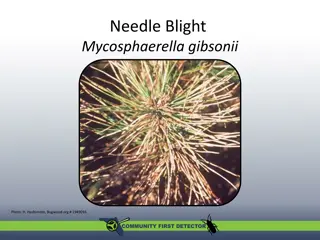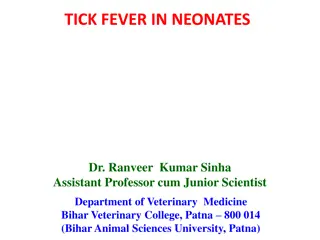Understanding Lyme Disease: Risks, Symptoms, and Prevention
Tick-borne diseases, particularly Lyme Disease, pose a significant health concern in the United States. Learn about the various diseases transmitted by infected ticks, the rise in Lyme Disease cases, who is at risk, and the symptoms to watch out for. Discover the basics of Lyme Disease, including its bacterial cause and early symptoms. Proper knowledge and prevention can help in protecting against these potentially serious illnesses.
Download Presentation

Please find below an Image/Link to download the presentation.
The content on the website is provided AS IS for your information and personal use only. It may not be sold, licensed, or shared on other websites without obtaining consent from the author. Download presentation by click this link. If you encounter any issues during the download, it is possible that the publisher has removed the file from their server.
E N D
Presentation Transcript
Ridgefield Health Department Ridgefield, CT 06877 Blastlyme.org
Which tick-borne diseases should we be concerned about? Several diseases can be acquired from the bite of an infected blacklegged (deer) tick: Lyme Disease Babesiosis Anaplasmosis Borrelia miyamotoi Powassan Disease P PHOTOGRAPH BY JIM GATHANY, CDC/PHIL/CORBIS
Named after first cases in Lyme, CT (1975) Photograph by Michael Patnaude, University of Florida.
Lyme disease in the United States According to the CDC, Lyme disease is the most commonly reported vector-borne illness in the United States with more than 300,000 new cases annually. In 2014, it was the 5th most common nationally reportable disease with 96% of confirmed cases reported from 14 states: Connecticut Delaware New York Maine Pennsylvania Maryland Rhode Island Vermont Virginia New Jersey Wisconsin New Hampshire Massachusetts Minnesota
Who gets tick-borne diseases? Everyone. Confirmed Lyme disease cases by age and sex--United States, 2001-2010
What exactly is Lyme disease? Lyme disease is a bacterial infection caused by the spirochete Borrelia burgdorferi. This organism attacks various organ systems in the body: Nervous System Activity System Circulatory System
Early Lyme disease symptoms Symptoms typically appear 2-30 days after the bite of an infected tick. Early symptoms: Expanding "bull's-eye" rash Flu-like Symptoms Fever Malaise Fatigue Headache Muscle aches Joint aches
Examples of the "bull's-eye" rash: L. Zemel S. Luger J. Stratton A. McDonald *Photos provided by Pfizer
Later signs and symptoms Severe headaches and neck stiffness Additional rashes Arthritis Facial or Bell's palsy Intermittent pain Heart palpitations or an irregular heart beat (Lyme carditis) Episodes of dizziness or shortness of breath Inflammation of the brain and spinal cord Nerve pain Shooting pains, numbness, or tingling Problems with short-term memory Source: National Library of Medicine
How is Lyme disease diagnosed? Lyme disease is diagnosed based on symptoms, physical findings (e.g., rash), and the possibility of exposure to infected ticks; laboratory testing is helpful if used correctly.
What is babesiosis? A malaria-like illness caused by a protozoan called Babesia microti. This parasite invades and lives within red blood cells. http://www.aafp.org Arrows indicate infected RBCs
Symptoms are mostly nonspecific, and the illness can range from very mild to very severe; although most people will not have symptoms. Symptoms may include: Fever Drenching sweats Muscle or joint aches or pains A blood test may find a breakdown of the red blood cells called hemolytic anemia
What is anaplasmosis? Anaplasmosis was formerly known as human granulocytic ehrlichiosis (HGE). These bacteria invade and live in white blood cells called granulocytes. Note the clumps of Ehrlichia in a white blood cell http://www.clevelandclinicmeded.com
Much like babesiosis, symptoms are mostly nonspecific, and the illness can range from very mild to very severe. Most patients will experience: Rapid onset of fever Shaking Chills Muscle or joint pain Severe headache Each tick-borne disease has its own test and may have a different treatment protocol.
Are there any vaccines? There was a vaccine for Lyme disease several years ago, but it is no longer available If you were previously vaccinated for Lyme disease you are NO LONGER protected There are no vaccines available for any of the tick-borne diseases, so PREVENTION is key
It varies based on their stage Adult Female: Reddish body size comparable to a sesame seed Adult Male: Slightly smaller than female, completely dark brown Nymph: Size comparable to that of a poppy seed Larva: Larvae may not transmit Lyme, but do transmit other diseases. Size smaller than that of a pin head From left to right: Adult female, adult male, nymph, larva
The two year tick life cycle Year One Spring Summer Autumn Winter Spring Summer Autumn Winter Year Two eggs larvae nymphs adults Meal 3 Meal 1 Meal 2 Adults mate, produce eggs & die Source: Center for Vector-Borne Disease, University of Rhode Island
When are you most likely to get Lyme disease? Confirmed Lyme disease cases by month of disease onset--United States, 2001-2010
Where do ticks live? Ticks thrive in shady, moist areas.
Whats the best way to remove a tick? Use fine-tipped tweezers. Grasp the tick by the mouthpart close to the skin. Pull straight back with a slow, steady force. Avoid crushing the tick s body. Place tick in a plastic vial or zip-lock bag for testing. Wash area and disinfect the bite site. Record the date and location of the bite. Watch for early symptoms.
Tick Removal DONTs Don t squeeze or rupture the tick. Don t pour kerosene or nail polish remover on the tick. Don t rub Vaseline or Petroleum Jelly on the tick. Don t do ANYTHING that might otherwise traumatize the tick.
Where do you send a tick for testing? Check with your local Health Department to see if they identify and/or test ticks. UMass Amherst Laboratory of Medical Zoology and University of Connecticut Veterinary Medical Diagnostic Laboratory identify and test ticks for a fee. University of Rhode Island Tick Encounter Resource Center and University of Maine Cooperative Extension Service identify ticks for free. Some private labs will test ticks for a fee. Don t wait for tick-testing results if you suspect that you have contracted a tick-borne disease. See your physician immediately!
Bathe or shower soon after coming indoors. Bathing or showering within 2 hours of outdoor activity helps remove ticks that haven t attached.
Look for ticks and rashes. Tick bites are usually painless, therefore most people are unaware when they have a tick attached to them. Ticks are very small, and may feed anywhere on the body, so check thoroughly. Check under your arms, in your ears, the belly button and behind your knees. Do a tick check every night. CDC
Apply repellents. SKIN If you choose to use a tick repellent on your skin, the CDC recommends using a product that contains DEET at a concentration of at least 20%. CLOTHING A permethrin based product is recommended for clothing and gear. It provides great protection against ticks! Photos CDC
Testing natural products to repel or kill ticks 2-undecanone Garlic oil Nookatone Mixed Essential Oils rosemary, thyme, lemongrass, geranio Fungus
Spray the edges of your yard. A single perimeter spray for tick control once in the Spring can reduce the number of ticks in your yard by up to 80- 90%. If you decide to spray your yard, it is best to hire a licensed professional who is trained to do this job efficiently and safely. Photo: JReid Tick Management Handbook, CT Agricultural Experiment Station
Create a Tick-Safe zone. Clear tall grasses and brush. Add a 3-ft wide barrier of wood chips or gravel between lawns and wooded areas. Mow the lawn frequently. Keep leaves raked. Stack wood neatly in a dry area. Keep playground equipment and patio furniture away from yard edges and in a sunny location. Choose deer resistant plants. Avoid feeding wild animals & birds. Westport/Weston Health District
Treat your pets. Check your pets for ticks after coming indoors. Ask your vet about vaccines and products that will help your pet repel ticks. Don t sleep with your pet because ticks on your pet may crawl on to you.
Join our team and help tackle tick-borne diseases!
Information provided by: Centers for Disease Control and Prevention (CDC) CT Agricultural Experiment Station Tick Management Handbook CT Department of Public Health Westport/Weston Health District Yale School of Public Health Peridomestic Lyme Disease Prevention: Results of a Population-Based Case Control Study Neeta P. Connally, PhD, Amanda J. Durante, PhD, Kimberly M. Yousey-Hindes, MPH, James I. Meek, MPH, Randall S. Nelson, DVM, Robert Heimer, PhD























